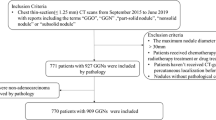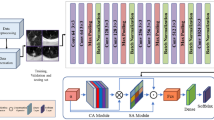Abstract
The early stage lung cancer often appears as ground-glass nodules (GGNs). The diagnosis of GGN as preinvasive lesion (PIL) or invasive adenocarcinoma (IA) is very important for further treatment planning. This paper proposes an automatic GGNs’ invasiveness classification algorithm for the adenocarcinoma. 1431 clinical cases and a total of 1624 GGNs (3–30 mm) were collected from Shanghai Cancer Center for the study. The data is in high-resolution computed tomography (HRCT) format. Firstly, the automatic GGN detector which is composed by a 3D U-Net and a 3D multi-receptive field (multi-RF) network detects the location of GGNs. Then, a deep 3D convolutional neural network (3D-CNN) called Attention-v1 is used to identify the GGNs’ invasiveness. The attention mechanism was introduced to the 3D-CNN. This paper conducted a contract experiment to compare the performance of Attention-v1, ResNet, and random forest algorithm. ResNet is one of the most advanced convolutional neural network structures. The competition performance metrics (CPM) of automatic GGN detector reached 0.896. The accuracy, sensitivity, specificity, and area under curve (AUC) value of Attention-v1 structure are 85.2%, 83.7%, 86.3%, and 92.6%. The algorithm proposed in this paper outperforms ResNet and random forest in sensitivity, accuracy, and AUC value. The deep 3D-CNN’s classification result is better than traditional machine learning method. Attention mechanism improves 3D-CNN’s performance compared with the residual block. The automatic GGN detector with the addition of Attention-v1 can be used to construct the GGN invasiveness classification algorithm to help the patients and doctors in treatment.









Similar content being viewed by others
References
Qiu Z X, Cheng Y, Liu D, et al. Clinical, pathological, and radiological characteristics of solitary ground-glass opacity lung nodules on high-resolution computed tomography[J]. Ther Clin Risk Manag, 2016, 12: 1445.
Shinohara S, Kuroda K, Shimokawa H, et al. Pleural dissemination of a mixed ground-glass opacity nodule treated as a nontuberculous mycobacterial infection for 6 years without growing remarkably[J]. J Thorac Dis, 2015, 7(9): E370.
Yamaguchi M, Furuya A, Edagawa M, et al. How should we manage small focal pure ground-glass opacity nodules on high-resolution computed tomography? A single institute experience[J]. Surg Oncol, 2015, 24(3): 258-263.
Travis W D, Brambilla E, Noguchi M, et al. International association for the study of lung cancer/American thoracic society/European respiratory society international multidisciplinary classification of lung adenocarcinoma[J]. J Thorac Oncol, 2011, 6(2): 244-285.
Hadji I, Wildes R P. What do we understand about convolutional networks?. arXiv preprint arXiv:1803.08834, 2018.
Wang S, Wang R, Zhang S, et al. 3D convolutional neural network for differentiating pre-invasive lesions from invasive adenocarcinomas appearing as ground-glass nodules with diameters ≤3 cm using HRCT[J]. Quant Imaging Med Surg, 2018, 8(5): 491.
Ren S, He K, Girshick R, et al. Faster r-cnn: Towards real-time object detection with region proposal networks[C]. Advances in neural information processing systems. 2015: 91-99.
Long J, Shelhamer E, Darrell T. Fully convolutional networks for semantic segmentation[C]// Proceedings of the IEEE conference on computer vision and pattern recognition. 2015: 3431-3440.
Zhu W, Liu C, Fan W, et al. Deeplung: Deep 3d dual path nets for automated pulmonary nodule detection and classification[C]// 2018 IEEE Winter Conference on Applications of Computer Vision (WACV). IEEE, 2018: 673-681.
Ronneberger O, Fischer P, Brox T. U-net: convolutional networks for biomedical image segmentation[C]// International Conference on Medical image computing and computer-assisted intervention. Springer, Cham, 2015: 234-241.
Dou Q , Chen H , Yu L , et al. Multi-level contextual 3D CNNs for False positive reduction in pulmonary nodule detection[J]. IEEE Trans Biomed Eng, 2016, PP(99):1-1.
Liu J, Li W, Huang Y, et al. Differential diagnosis of the MDCT features between lung adenocarcinoma preinvasive lesions and minimally invasive adenocarcinoma appearing as ground-glass nodules[J]. Zhonghua zhong liu za zhi [Chinese journal of oncology], 2015, 37(8): 611-616.
Hwang I, Park C M, Park S J, et al. Persistent pure ground-glass nodules larger than 5 mm: differentiation of invasive pulmonary adenocarcinomas from preinvasive lesions or minimally invasive adenocarcinomas using texture analysis[J]. Investig Radiol, 2015, 50(11): 798-804.
Deng J, Dong W, Socher R, et al. Imagenet: A large-scale hierarchical image database[C]// 2009 IEEE conference on computer vision and pattern recognition. Ieee, 2009: 248-255.
Hu J, Shen L, Sun G. Squeeze-and-excitation networks[C]// Proceedings of the IEEE conference on computer vision and pattern recognition. 2018: 7132-7141.
Wang F, Jiang M, Qian C, et al. Residual attention network for image classification[C]// Proceedings of the IEEE Conference on Computer Vision and Pattern Recognition. 2017: 3156-3164.
He K, Zhang X, Ren S, et al. Deep residual learning for image recognition[C]// Proceedings of the IEEE conference on computer vision and pattern recognition. 2016: 770-778.
Lin T Y , Goyal P , Girshick R , et al. Focal loss for dense object detection[J]. IEEE Trans Pattern Anal Mach Intell, 2017, PP(99):2999-3007.
Gilbert C D, Wiesel T N. Receptive field dynamics in adult primary visual cortex[J]. Nature, 1992, 356(6365): 150-152.
Itti L, Koch C. Computational modelling of visual attention[J]. Nat Rev Neurosci, 2001, 2(3): 194-203.
Fu J, Liu J, Tian H, et al. Dual attention network for scene segmentation[C]// Proceedings of the IEEE Conference on Computer Vision and Pattern Recognition. 2019: 3146-3154.
Anderson P, He X, Buehler C, et al. Bottom-up and top-down attention for image captioning and visual question answering[C]// Proceedings of the IEEE conference on computer vision and pattern recognition. 2018: 6077-6086.
Chang J S, Luo Y F, Su K Y. GPSM: a generaized probabilistic semantic model for ambiguity resolution[C]// Proceedings of the 30th annual meeting on Association for Computational Linguistics. Association for Computational Linguistics, 1992: 177-184.
Kohavi R. A study of cross-validation and bootstrap for accuracy estimation and model selection[C]// Ijcai. 1995, 14(2): 1137-1145.
Ling C X, Huang J, Zhang H. AUC: a better measure than accuracy in comparing learning algorithms[C]// Conference of the Canadian society for computational studies of intelligence. Springer, Berlin, 2003: 329-341.
Armato S G, Mclennan G, Bidaut L, et al. The lung image database consortium (LIDC) and image database resource initiative (IDRI): a completed reference database of lung nodules on CT scans [J]. Med Phys, 2011, 38(2): 915-931.
Ding J , Li A , Hu Z , et al. Accurate pulmonary nodule detection in computed tomography images using deep convolutional neural networks[J]. 2017.
LeCun Y, Bengio Y, Hinton G. Deep learning[J]. Nature, 2015, 521(7553): 436-444.
Rumelhart D E, Hinton G E, Williams R J. Learning representations by back-propagating errors[J]. Nature, 1986, 323(6088): 533-536.
Lorensen W E, Cline H E. Marching cubes: A high resolution 3D surface construction algorithm[J]. ACM Siggraph Comput Graph, 1987, 21(4): 163-169.
Tetko I V, Livingstone D J, Luik A I. Neural network studies. 1. Comparison of overfitting and overtraining[J]. J Chem Inf Comput Sci, 1995, 35(5): 826-833.
Keskar N S, Mudigere D, Nocedal J, et al. On large-batch training for deep learning: generalization gap and sharp minima. In The International Conference on Learning Representations (ICLR), 2017.
Author information
Authors and Affiliations
Corresponding author
Ethics declarations
Conflict of Interest
The authors declare that they have no conflict of interest.
Ethical Statement
Ethical approval was obtained for this retrospective analysis, and informed consent requirement was waived.
Additional information
Publisher’s Note
Springer Nature remains neutral with regard to jurisdictional claims in published maps and institutional affiliations.
Rights and permissions
About this article
Cite this article
Ni, Y., Yang, Y., Zheng, D. et al. The Invasiveness Classification of Ground-Glass Nodules Using 3D Attention Network and HRCT. J Digit Imaging 33, 1144–1154 (2020). https://doi.org/10.1007/s10278-020-00355-9
Published:
Issue Date:
DOI: https://doi.org/10.1007/s10278-020-00355-9




